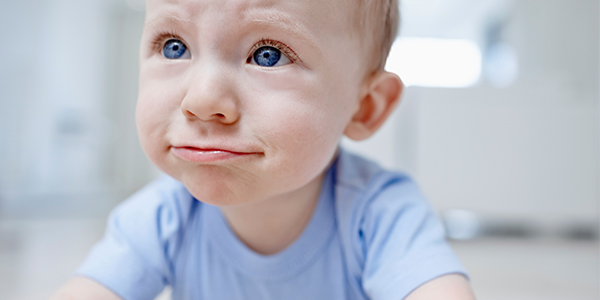Babies Cry Less in the First Three Months When
What's a Normal Amount of Crying?
Larn about different types of crying and what y'all can do to soothe your baby.
There is a huge range of normal crying in babies through the first 12 weeks of life. At one terminate, a infant will barely fuss, fall comatose hands and feed on a predictable pattern. At the other farthermost is the baby who wakes screaming, sleeps inconsistently and feeds on a random schedule.

Although all babies cry, when crying becomes more frequent or lasts hours, some parents may wonder if they should be worried it'south something more serious.
"It'south always pitiful for parents when they see their infant crying, only it'south a normal response," says Arlene Hay, M.D., pediatrician at the Sutter Medical Foundation in Sacramento. "Infants accept a weep reflex – it's their first verbal communication. They're just releasing tension and it's a normal behavioral activeness."
Crying is a normal beliefs that can happen daily, at least for the first few months. Although information technology is stressful for parents, Dr. Hay says the trick is to call up it will get improve.
Everyday Crying
Babies lack the skills to self soothe, and so until 3 months of age they cry more than, Dr. Hay explains. "Information technology's very normal for there to be some daily fussiness. Crying up to three hours a day is still within a normal range."
When your baby is around 3 months old, the crying probable volition decrease to one hour or less a day, although some babies may cry regularly until they are v months of historic period, she says.
"It'south non the parent's mistake the babe cries, it's but a phase the infant has to go through. But, parents practice still demand to distinguish between normal crying and a ill baby. If your baby has a temperature, see your pediatrician right away."
Calming and Soothing
Getting to know what your baby likes is the all-time way to observe how to calm and soothe him, Dr. Hay advises. "If your baby is crying considering she is overstimulated, a calmer environment may help soothe her. But other babies will cry because they desire more than stimulation."
Dr. Hay recommends trying different holding techniques to soothe a crying baby, including skin-to-skin contact, hugging, stroking the baby's head, patting the back or breast, carrying and walking the baby in your arms, and burping to relieve any trapped gas bubbles.
If belongings doesn't help, try talking or singing to the babe, playing soft music or rhythmic noises and vibrations, she says. A warm bath may besides aid. If your baby is ii months sometime or younger, swaddling in a receiving blanket is a proficient strategy.
The Myth of Spoiled Babies
You may have heard a baby will be "spoiled" if she is held likewise much or if parents answer also quickly to crying, but research disproves these old wives' tales. How fast you respond to your baby's crying is just equally important for reducing daily fussiness equally how you respond.
Studies have institute that babies who cry less are the ones who are carried more – fifty-fifty when they're happy or asleep. Responding promptly to a baby'southward cries results in less crying and a more confident and independent child, co-ordinate to the American Academy of Pediatrics. Holding, rocking or feeding your baby as ofttimes as needed is exactly the correct approach.
Crying Too Much
If a babe cries suddenly, for no apparent reason and is inconsolable, parents have a trend to panic and jump to the decision that excessive crying is colic, Dr. Hay says.
Colic is hard and uncontrollable crying that lasts for more than three hours a day, more three days a week, in an otherwise healthy baby. It usually occurs late in the afternoon or early evening when parents are too tired. The causes of colic are mostly a mystery and the effectiveness of treatments varies from baby to baby, she says.
"Excessive crying that lasts longer than three hours a day is suspicious for colic," Dr. Hay says. "Just research from child development experts like Ronald Barr, M.D., suggests that well-nigh of these babies are in the Menstruum of Imperial crying, not colic."
PURPLE is an acronym that describes characteristics of normal crying during this phase of development: peak of crying, unexpected, resists soothing, pain-like confront, long-lasting and evening. It'south called a "menstruation" to emphasize that this stage is only temporary.
Crying is part of a healthy baby's evolution, simply if you experience your baby is crying too much, you should bank check with your pediatrician. There is always a possibility your babe could have GERD (acrid indigestion), food allergies or lactose intolerance.
A Note on Breastfeeding
Sometimes the nutrition of a breastfeeding mom may contribute to her babe'south fussiness. It can help to go along a food diary and encounter if you tin can spot a relationship. Your doctor may also recommend you cutting dairy products, spicy foods and gassy foods like cabbage and broccoli, Dr. Hay says.
If endless breastfeeding seems to be the only way to calm your baby, yous might want to meet a lactation consultant to make sure breastfeeding is going well. A trivial hunger tin can cause a lot of fussing.
Related Articles
More Resources
Source: https://www.sutterhealth.org/health/childrens-health/whats-a-normal-amount-of-crying
Belum ada Komentar untuk "Babies Cry Less in the First Three Months When"
Posting Komentar